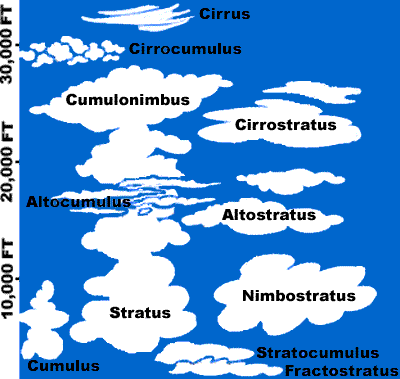 |
||
| First page | ||
 |
||
| High clouds | ||
 |
||
| Middle clouds | ||
 |
||
| Low clouds | ||
 |
How/Why study? | |
 |
||
| Find out more | ||
 |
||
 |
||
This section about clouds will show you some pictures and characteristics of different clouds. The names used here are used universally by people that work with weather. The different sorts of clouds are mainly
* Cirrus
* Cumulus (thread cloud)
* Stratus (heaped cloud)
* Nimbus (layer cloud)
There are 10 main groups of clouds and these are divided into three levels in the sky depending on the altitude they're at, as you can see in the image below.

A cloud consists of small particles of water or ice, or of both, in the air. Clouds come in many sizes and what seems to be an endless variety of shapes and colours. They can look everything from beautiful or scary to grey and dull.
Clouds are usually formed when moist air moves upward and cools. This is because cool air holds less water vapor than warm air, so the vapor turns into either liquid or ice and this is what we see as a cloud. However, a cloud consists mostly of air since drops of water or ice particles often make up as little as one millionth of the volume. When a cloud forms at relatively warm temperatures the particles are usually tiny liquid drops and at very low temperatures usually ice. The higher the temperature of the air the greater the volume of water vapour it can absorb. The temperature in the Earth's atmosphere decreases when the distance from Earth gets larger and the most common way to form a cloud is to force air to rise to a cooler region.
You might have noticed something similar in your bathroom when warm, moist air from above the bathwater comes into contact with a cold wall, mirror or window and leaves tiny drops of water there.
15th October 2000
Sarah Amandusson
www_astro@mssl.ucl.ac.uk